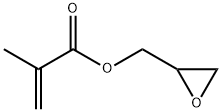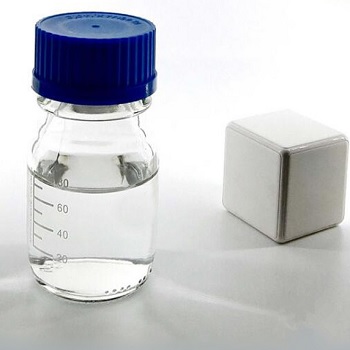
Product Introduction
| Glycidyl methacrylate Basic information |
| Product Name | Glycidyl methacrylate |
| Synonyms | Glycidyl Methacrylate, stabilized, 97% 100GR;Glycidyl Methacrylate, stabilized, 97% 500GR;2-Methyl-2-oxiranyl-2-propenoic acid Methyl ester;Glycidyl Methacrylate OR Methacrylic acid 2,3-epoxypropyl ester;blemmergma;CP 105;cp105;Glycidol methacrylate |
| CAS | 106-91-2 |
| MF | C7H10O3 |
| MW | 142.15 |
| EINECS | 203-441-9 |
| Product Categories | Oxiranes;Simple 3-Membered Ring Compounds;Acrylic Monomers;Building Blocks;Chemical Synthesis;Epoxides;Materials Science;Methacrylate;Monomers;Organic Building Blocks;Oxygen Compounds;Polymer Science;GM;GMA;bc0001 |
| Mol File | 106-91-2.mol |
 |
|
| Glycidyl methacrylate Chemical Properties |
| Melting point | -52°C |
| Boiling point | 189 °C(lit.) |
| density | 1.075 g/mL at 20 °C |
| vapor pressure | 4.2hPa at 25℃ |
| refractive index | n20/D 1.449(lit.) |
| Fp | 169 °F |
| storage temp. | 2-8°C |
| solubility | Chloroform (Slightly), Methanol (Slightly) |
| form | Liquid |
| color | Clear |
| Water Solubility | 0.5-1.0 g/100 mL at 20 ºC |
| BRN | 2506 |
| Stability: | Unstable. Light sensitive. May be stabilized with around 100ppm MEHQ. Refrigerate. |
| InChIKey | VOZRXNHHFUQHIL-UHFFFAOYSA-N |
| LogP | 0.96 at 25℃ |
| CAS DataBase Reference | 106-91-2(CAS DataBase Reference) |
| IARC | 2A (Vol. 125) In prep. |
| NIST Chemistry Reference | 2-Propenoic acid, 2-methyl-, oxiranylmethyl ester(106-91-2) |
| EPA Substance Registry System | Glycidyl methacrylate (106-91-2) |
| Safety Information |
| Hazard Codes | Xn,T,T+ |
| Risk Statements | 20/21/22-36/38-43-60-45-68-39/26-34 |
| Safety Statements | 26-28-28A-45-36/37-53-36/37/39 |
| RIDADR | UN 2810 6.1/PG 3 |
| WGK Germany | 2 |
| RTECS | OZ4375000 |
| TSCA | Yes |
| HazardClass | 8 |
| PackingGroup | III |
| HS Code | 29161490 |
| Hazardous Substances Data | 106-91-2(Hazardous Substances Data) |
| Toxicity | dog,LCLo,inhalation,1400mg/m3/6H (1400mg/m3),LUNGS, THORAX, OR RESPIRATION: OTHER CHANGES,National Technical Information Service. Vol. OTS0530684, |
| MSDS Information |
| Provider | Language |
|---|---|
| 2,3-Epoxypropyl methacrylate | English |
| ACROS | English |
| SigmaAldrich | English |
| ALFA | English |
| Glycidyl methacrylate Usage And Synthesis |
| Description | Glycidyl Methacrylate (GMA) is a clear, colorless liquid with a potent ester and fruity odor. It comprises a polymerizable methacrylate functional group on one end and a reactive epoxy group on the other. It is slightly miscible with water, soluble in most organic solvents, and has relatively low volatility. Its vapor is heavier than air. It copolymerizes readily with various functional groups, such as phenols, ketones, acids, and amines. The added epoxy group imparts durability, mechanical strength, optical transparency, and adhesiveness. |
| Chemical Properties | Glycidyl methacrylate (GMA) is a colorless liquid with a fruity odor. Floats on water. (USCG, 1999) Glycidyl methacrylate is a polyfunctional monomer. It acts as an adhesion promoting crosslinking co-monomer for acrylic and vinyl resins. It is also a reactive colorless diluent. GMA is soluble in ethanol, acetone, diethyl ether, benzene. |
| Uses | Glycidyl methacrylate (GMA) is a common monomer used in the creation of epoxy resins. It is used to provide epoxy functionalization to polyolefins and other acrylate resins. Glycidyl methacrylate is used in the production of polymer coatings and finishes, adhesives, plastics and elastomers. Glycidyl methacrylate dextran has been reported to be used as a biocompatible hydrogel. In situ polymerization of GMA with trimethylolpropane trimethacrylate to form macroporous sorbents has also been reported. GMA may also be grafted onto polypropylene. |
| Uses | Glycidyl methacrylate is commonly used as a monomer for the preparation of epoxy resins. It is also used to provide epoxy functionalization to polyolefins and other acrylate resins. Further, it is also useful as an epoxy resin additive for paint coating formulations and adhesive applications. |
| Definition | ChEBI: Glycidyl methacrylate is an enoate ester obtained by formal condensation of the carboxy group of methacrylic acid with the hydroxy group of glycidol. It is an enoate ester and an epoxide. It is functionally related to a methacrylic acid and a glycidol. |
| Preparation | Glycidyl methacrylate is produced from methacrylic acid and glycidol. Glycidol contain both epoxide and alcohol functional groups.It is an enoate ester and an epoxide. It derives from a methacrylic acid and a glycidol. |
| Reactions | Glycidyl methacrylate (GMA) is a kind of functional monomer. Its active vinyl and epoxy groups could be grafted with polyolefin and reacted with the polar groups such as amine, hydroxyl and carboxyl group, respectively. It can also undergo polymerization to form poly (glycidyl methacrylate). |
| Synthesis Reference(s) | Tetrahedron, 48, p. 5099, 1992 DOI: 10.1016/S0040-4020(01)90120-6 Synthesis, p. 1019, 1986 DOI: 10.1055/s-1986-31856 |
| General Description | Colorless liquid with a fruity odor. Floats on water. |
| Air & Water Reactions | Flammable. Slightly water soluble. |
| Reactivity Profile | Epoxides, such as Glycidyl methacrylate, are highly reactive. They polymerize in the presence of catalysts or when heated. These polymerization reactions can be violent. Compounds in this group react with acids, bases, and oxidizing and reducing agents. They react, possibly violently with water in the presence of acid and other catalysts. |
| Health Hazard | The liquid irritates eyes about as much as soap. Prolonged contact with skin produces irritation and dermatitis. |
| Fire Hazard | Special Hazards of Combustion Products: Irritating vapors are generated when heated |
| Flammability and Explosibility | Flammable |
| Glycidyl methacrylate Preparation Products And Raw materials |
| Raw materials | Sodium hydroxide-->Epichlorohydrin-->Methacrylic acid-->SODIUM METHACRYLATE |
| Preparation Products | water-soluble organosilicone softening agent-->2-Propenoic acid, 2-methyl-, 3-hydroxy-2-[(1-oxo-2-propen-1-yl)oxy]propyl ester-->2,2-BIS[4-(2-HYDROXY-3-METHACRYLOXYPROPOXY)PHENYL]PROPANE-->3-(ACRYLOYLOXY)-2-HYDROXYPROPYL METHACRYLATE-->3-CHLORO-2-HYDROXYPROPYL METHACRYLATE |
Hot Tags: glycidyl methacrylate, China glycidyl methacrylate manufacturers, suppliers, factory, CAS 7328 17 8, Mono-functional, Propoxylated Trimethylolpropane Triacrylate, CAS 5888 33 5, Dodecyl 2 methylacrylate, CAS 142 90 5
You Might Also Like
-
![BIS[2-(2-BUTOXYETHOXY)ETHOXY]METHANE](/uploads/41226/small/bis-2-2-butoxyethoxy-ethoxy-methaned94af.jpg?size=336x0)
BIS[2-(2-BUTOXYETHOXY)ETHOXY]METHANE
-

1,2-cyclohexanediol Diglycidyl Ether
-

High Quality and Purity Tributyl Citrate/TBC CAS 77-94-1
-

PPG-200/400/600/1000/1500/2000/3000/4000/8000 Polypropylene Glycol CAS 25322-69-4
-

Factory Sell DEAP CAS 6175-45-7 2, 2-Diethoxy Acetophenone
-

Factory Direct Sales Light Stabilizer 292 UV 292 CAS 82919-37-7&41556-26-7
Send Inquiry

